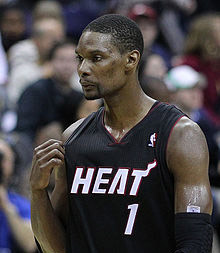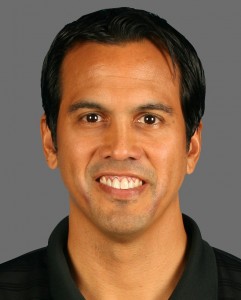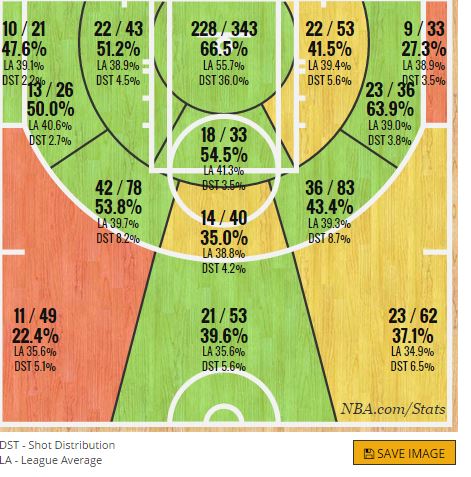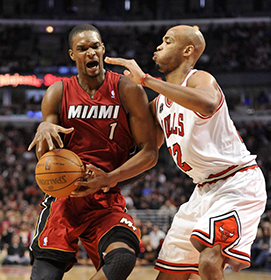 “It’s a lot to take in but that’s what I asked for,” said Miami Heat forward Chris Bosh on a rainy Monday night in Brooklyn. Bosh is still trying to take in the many responsibilities he accepted and undertook when he returned to Miami in July after LeBron James’ departure to Cleveland.
“It’s a lot to take in but that’s what I asked for,” said Miami Heat forward Chris Bosh on a rainy Monday night in Brooklyn. Bosh is still trying to take in the many responsibilities he accepted and undertook when he returned to Miami in July after LeBron James’ departure to Cleveland.
Bosh took on Miami’s leading role after four years of being a supporting player. Bosh is now the team’s vocal leader and its top scorer, creator and facilitator. Shots are now harder to make with opposing defenses primarily focused on him. A new playing style on both ends of the floor confronts Bosh during every game and practice.
Chris Bosh is up for the challenge despite many evident growing pains early on.
Bosh leads the team in minutes, scoring, rebounding, free throws and usage rate but his shooting numbers are way down as he adjusts to his new role.
“It’s extremely frustrating to go through it so far but that’s a part of it,” Bosh said. “The coaching staff has really been on me to be a leader and be an inspiration to the guys no matter how the game is going. So I just have to be that voice every day. So as long as I’m doing that I’m sure my game will catch up.”
Heat coach Erik Spoelstra is very upfront about how much his team is leaning on Bosh right now.
 “Welcome to our team this year and what’s necessary for us to win,” Spoelstra said. “He has to do a lot and he embraces all that. The challenges are on his shoulders this year on both ends of the court.”
“Welcome to our team this year and what’s necessary for us to win,” Spoelstra said. “He has to do a lot and he embraces all that. The challenges are on his shoulders this year on both ends of the court.”
“In order for us to be successful, we’re going to need him to play at a high level and be a threat from all areas on the court,” said Miami point guard Norris Cole.
Veterans on this team have noticed the difference in Bosh and how he’s become the Heat’s leader.
“He’s more vocal. He definitely carries a lot on his shoulders and he’s very passionate about it,” Chris “Birdman” Andersen told SheridanHoops. “So he takes it extremely seriously and leads the rest of us.”
Those challenges begin with the new approach he’s had to take on offense. Bosh is now a team’s No. 1 option for the first time since his Toronto days and he’s had to get acquainted to that role again.
“Now it’s a re-learning process. It’s different,” Bosh said. “I’m doing things that I was trying to do four years ago and it worked back then but now it’s not so much the case dealing with the scouting reports again. Dealing with guys playing me a certain way.”
Bosh was a huge beneficiary of James drawing attention and coverages defensively and said his role offensively for those Heat teams was, essentially, to shoot the ball or move it to another facilitator.
“I had to get the ball in the hands of those guys who did the creating and usually I was the beneficiary,” Bosh said. And that manifested itself in his shot chart last year.

Bosh was able to excel in the restricted area and the paint because of all the open looks he got. He was phenomenal in the mid-range and on the perimeter. He shot higher than the league average percentage in eight of the 14 NBA offensive shot zones and shot 51.6 percent from the field last season. As evidenced by the following chart, things have not come as easy this year for Bosh as he’s played a much more important role on the team.
| Chris Bosh | Usage Rate | FG % | 3 FG % | Points | Rebounds | Assists | PER | True Shooting | O Rating | D Rating | WS/48 |
| 2013-2014 | 22.6 | 51.6 | 33.9 | 16.2 | 6.6 | 1.1 | 19 | 59.7 | 112 | 104 | 0.152 |
| 2014-2015 | 28.4 | 41.5 | 30.8 | 19.9 | 8.7 | 2.9 | 20.9 | 53.1 | 106 | 103 | 0.139 |
His shooting from the field has gone down tremendously, over 10 percentage points lower this year than last. Miami scores six fewer points per 100 possessions with Bosh on the floor this year than a year ago, but that could be, and probably is, caused by James’ departure. The rebounds and assist numbers are up but getting quality shots is a lot harder for Bosh this season. Take a look at his shot chart this year and how it relates to last year’s.

Have you taken a moment to compare the two charts? Good, because they’re far different from one another.
Bosh’s shooting percentages are down as he attracts more attention, teams game-plan for him more.
 For starters, 36 percent of Bosh’s shots were in the restricted area last year compared to 29.2 this year. Last year he shot 66.5 percent in the restricted area. That number is down to just 48 percent this year. Midrange jumpers accounted for just 27.6 percent of his shot attempts last year. That number is up to 33.3 percent this year and his shooting percentage from that distance is now at 42.1 percent, down from 48.7 percent last year. His 3-point attempts are basically being shot at the same rate, up from 22.4 to 22.7 percent of his shots, but his success rate is down more than three percentage points.
For starters, 36 percent of Bosh’s shots were in the restricted area last year compared to 29.2 this year. Last year he shot 66.5 percent in the restricted area. That number is down to just 48 percent this year. Midrange jumpers accounted for just 27.6 percent of his shot attempts last year. That number is up to 33.3 percent this year and his shooting percentage from that distance is now at 42.1 percent, down from 48.7 percent last year. His 3-point attempts are basically being shot at the same rate, up from 22.4 to 22.7 percent of his shots, but his success rate is down more than three percentage points.
Bosh said that he’s getting the same looks offensively, but more of his shots are coming from that midrange area because of how he’s being guarded this season.
“There’s more contests. Guys are a little bit closer to me,” Bosh said. “Before I could work off the closeouts and work off open shots. Now, not so much. Those come in small volumes.”
NBA.com has a new function on their stats site that, thanks to the SportVu cameras, tracks how close defenders are to shooters when they attempt field goals.
If the closest defender to a shooter is two feet or fewer away, NBA.com calls that a “very tight” shot. Between two and four feet is “tight,” four to six feet is “open” and if the closest defender is at least six feet away from the shooter that’s deemed “wide open.”
| Bosh’s Closest Defender | 0-2 Feet | 2-4 Feet | 4-6 Feet | 6+ Feet |
| 2013-2014 | 15.2 | 24.4 | 28.9 | 31.5 |
| 2014-2015 | 12.3 | 31.6 | 33.3 | 22.8 |
Bosh took a staggering 60.4 percent of his shots last year when he was open or wide open. That’s down to 56.1 percent this year. The biggest difference is Bosh taking a lot more tightly defended shots this year, 31.6 percent of his shots compared to when 24.4 last year when James was around, and that’s reflected in his overall shooting percentage.
Spoelstra said he and his staff are trying to help get Bosh back in his comfort zone while adapting to having to shoulder all these responsibilities for the team this season.
“We have to get him in positions, all of us, where he can feel comfortable to make plays for the team but also for himself,” Spoelstra said. “And he has to shoulder some responsibility to find ways to be aggressive. What I mentioned to him today was let’s not overreact. Let’s not get caught up in all the drama of all the storylines. He’s been through this before many times. He’ll work it out and he knows how to play the game.”
Bosh said he’s trying to roll and get to the basket more via transition buckets and offensive rebounds and is still trying to find his rhythm offensively.
Miami is 6-5 on the season, more than treading water in the Eastern Conference, and Spoelstra and the rest of the Heat players believe in Bosh’s ability to find his way.
“He needs to facilitate, he needs to get us into actions and be our guy that we run offense through and read the defense and when he’s able to attack or whether he needs to get somebody involved,” Spoelstra said. “I trust him as much as I trust anybody to do all those things.”
Shlomo Sprung is a national columnist for SheridanHoops who loves advanced statistics and the way they explain what happens on the court. He is also the web editor of the Brooklyn Daily Eagle. A 2011 graduate of Columbia University’s Journalism School, he has previously worked for the New York Knicks, The Sporting News, Business Insider and other publications. You should follow him on Twitter.
Bosh was a big fish in a small pond when he played for the Raptors. Looks like he is assuming the same role again with the Heat. I’m sure he will be just fine.